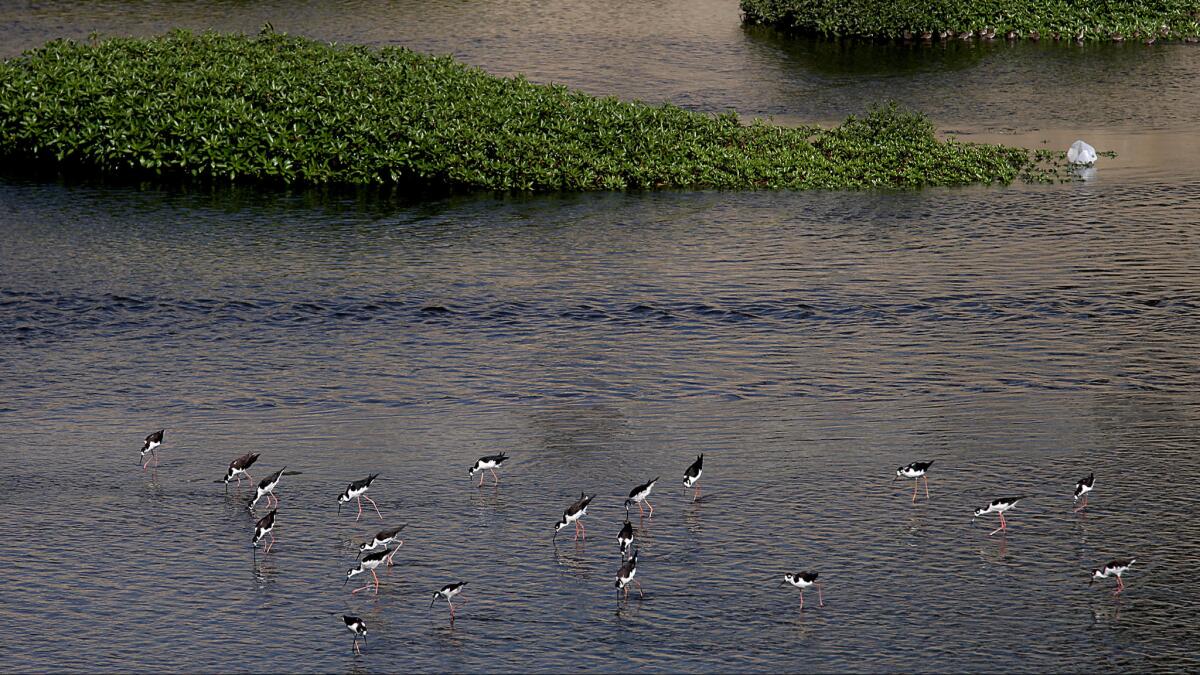A ‘crown jewel’ of the L.A. River project could cost $252 million

The rail yard might become part of the L.A. River
A plan for turning a former rail yard next to the Los Angeles River into park space, wetlands and other amenities could cost more than $252 million, city analysts said in a report Thursday.
The City Council voted in May to allocate $40 million for the purchase of the vacant site, which is owned by railroad company Union Pacific and referred to as Parcel G2. But the overall project, including the removal of contaminated soil, could reach six times that amount, according to the 91-page report.
Mayor Eric Garcetti has championed the G2 project for years, describing the property as a “crown jewel” of a larger, 11-mile river restoration initiative. He and the council must decide over the next few weeks whether to move ahead with a purchase of the site, which sits on the north side of the river next to Rio De Los Angeles State Park.
Asked about the estimates, Garcetti said through an aide that he remains committed to the purchase of the property. The G2 site will create “41 acres of much-needed green space in the heart of L.A.,” said his spokeswoman, Connie Llanos.
Councilman Gil Cedillo also renewed his support for the G2 purchase, calling the project “an issue of environmental justice” for his Eastside district. In a statement, he said the G2 site would provide his constituents in Cypress Park and other nearby neighborhoods a critical access point to the river.
“This is a long-term project that is not going to happen overnight,” Cedillo said. “We must take it step by step, and first and foremost is securing the land.”
Thursday’s report makes clear that the 11-mile river project, which stretches from the northern end of Griffith Park to downtown Los Angeles, will be considerably costlier than it was billed two years ago. The price tag for the overall initiative — purchasing land, ripping out concrete, adding water cleanup features, reintroducing native habitat, among other things — is expected to reach nearly $1.6 billion, the report says.
The river project was portrayed as a $1-billion initiative two years ago. At that time, city officials voiced hopes that the cost would be split 50-50 with the federal government, primarily the U.S. Army Corps of Engineers. Now, city analysts say Los Angeles could find itself shouldering 76% of the financial burden. But they point out that city leaders could choose to pursue some projects in the 11-mile river plan and not others.
At the G2 site, the biggest cost is expected to be soil cleanup, which has been estimated at more than $120 million, according to the report prepared by City Administrative Officer Miguel Santana and Chief Legislative Analyst Sharon Tso.

Richard Close, president of the Sherman Oaks Homeowners Assn., voiced concerns about devoting so much money to one section of the city. Politicians at City Hall should initiate a broader discussion of the G2 site and the larger river project, he said.
The city needs to “analyze whether this is a fair amount for 41 acres,” Close said. “And No. 2, is this a location that really needs the parkland the most? There are areas of the San Fernando Valley that have been asking for parkland for decades.”
Santana said the report to the council lays out two choices for the city’s elected leaders: buying the property or not buying it.
“They’ve adopted an [environmental impact report] to restore the river. This is a first major step in that direction,” he said. “It’s our job to present them with the immediate cost, as well as the potential long-term cost of this investment.”
Santana said the city will need to spend the coming years identifying federal, state and local funds to cover the cost of the G2 project. So far, the federal government is expected to provide $25.4 million. State Sen. Kevin de León identified an additional $25 million for the site last year.
Garcetti and the council have until Oct. 31 to open escrow on the G2 site. If that deadline is missed, the property could be subject to a new appraisal, resulting in a higher purchase price, Santana said.
Supporters of the river restoration say the city would make a huge mistake in passing up on the purchase. If the city does not buy the G2 site, Union Pacific will “sell it to some God-awful industry, they’ll pave it over and that’ll be it,” said Joe Edmiston, executive director of the Santa Monica Mountains Conservancy.
“I think the people of Los Angeles want to have a restored river,” he added.
Parcel G2 was for several decades part of the Taylor Yard railroad complex. The property was used as recently as 2006 for fueling and maintenance operations, according to an environmental review prepared in 2014. Soil and groundwater at the site contains arsenic, lead and other contaminants.
The City Council voted to begin property negotiations with Union Pacific in December 2013. In an email, Union Pacific spokesman Justin Jacobs said his company has completed negotiations with the city and is awaiting a decision by the council.
Twitter: @DavidZahniser
ALSO
Union alleges illegal foreign money is flowing into ballot fight over Beverly Hills hotels
Southland air quality regulators mulling hike in vehicle registration fees for smog reduction
Beach fort erected by ‘Bay Boys’ surfer gang will be demolished, Palos Verdes Estates officials say
More to Read
Sign up for Essential California
The most important California stories and recommendations in your inbox every morning.
You may occasionally receive promotional content from the Los Angeles Times.











